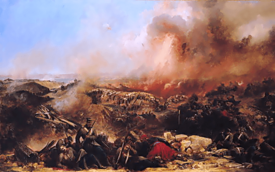John Alexander (VC) facts for kids
Quick facts for kids
John Alexander
|
|
|---|---|

Depiction of the Siege of Sebastopol
|
|
| Born | Mullingar, County Westmeath, Ireland |
| Died | 24 September 1857 Alumbagh, Lucknow, British India |
| Allegiance | |
| Service/ |
British Army |
| Rank | Private |
| Unit | 90th Perthshire Light Infantry |
| Battles/wars | Crimean War Indian Mutiny |
| Awards | Victoria Cross Médaille Militaire (France) |
John Alexander was a brave soldier from Ireland who served in the British Army. He is famous for receiving the Victoria Cross (VC). This is the highest award for bravery a soldier can get in the British and Commonwealth forces. He died on September 24, 1857.
Born in Mullingar, County Westmeath, Ireland, John Alexander was a Private. This is a common rank for soldiers. He served in the 90th Perthshire Light Infantry. This army unit is now known as The Cameronians (Scottish Rifles).
Contents
His Amazing Bravery
John Alexander showed incredible courage during the Crimean War. This war took place between 1853 and 1856.
Saving Wounded Soldiers
On June 18, 1855, there was a big attack at Sevastopol. This was a city in Crimea. After the attack, Alexander left the safety of his trenches. He went out under very heavy enemy fire. He bravely brought several wounded soldiers back to safety.
Helping a Wounded Captain
Later, on September 6, he was with a group of soldiers. They were working in a very dangerous trench. Again, he went out under heavy fire. He helped to bring in a captain who was badly hurt. Because of these brave actions, he was given the Victoria Cross. He also received the Médaille Militaire from France.
His Final Battle
John Alexander was later killed in action. This means he died while fighting in a battle. This happened during the Siege of Lucknow. The siege was part of the Indian Mutiny, also known as the Indian Rebellion of 1857. He died on September 24, 1857, in Alumbagh, Lucknow, which was then part of British India.
Where to See His Medal
Private Alexander's Victoria Cross is a very important medal. You can see it on display today. It is kept at the National War Museum of Scotland. This museum is located at Edinburgh Castle in Scotland.

